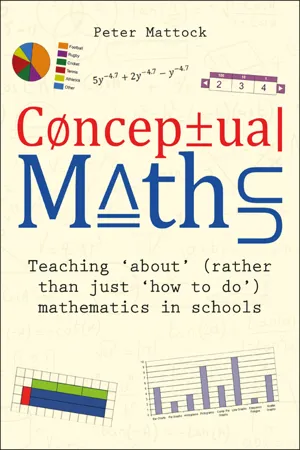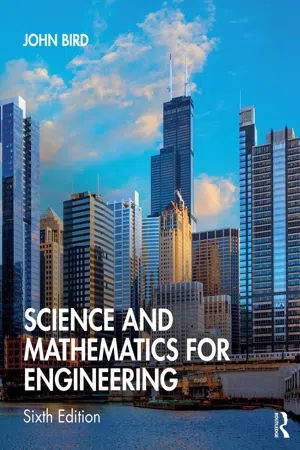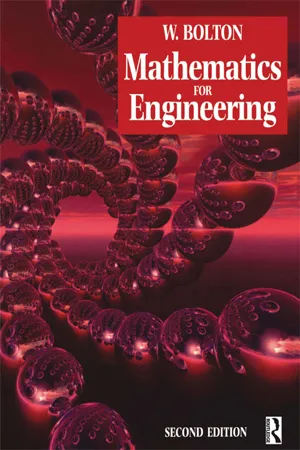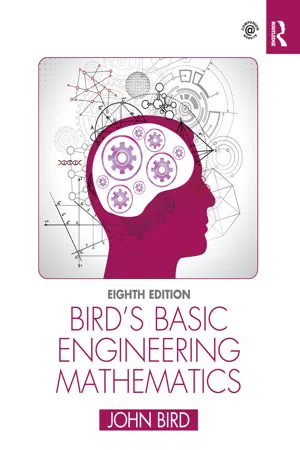Mathematics
Surface Area of Cylinder
The surface area of a cylinder is the total area of all its surfaces, including the two circular bases and the curved surface. To calculate the surface area, one can use the formula 2πr² + 2πrh, where r is the radius of the base and h is the height of the cylinder. This measurement is important in various real-world applications and mathematical problems.
Written by Perlego with AI-assistance
Related key terms
5 Key excerpts on "Surface Area of Cylinder"
- eBook - ePub
Conceptual Maths
Teaching 'about' (rather than just 'how to do') mathematics in schools
- Peter Mattock(Author)
- 2023(Publication Date)
- Crown House Publishing(Publisher)
However we arrive at it (including potentially just providing the formula directly), one important aspect of the surface area formula that pupils should appreciate (either through their own insight or having been explicitly taught it) is that the surface area of the sphere is four times bigger than that of the circle created by the equator of the sphere. Offering pupils a question like the one below might prompt this awareness or might be used to reinforce it if the relationship has been explicitly taught:A sphere is cut into two pieces along the equator to form two hemispheres as shown. Each hemisphere rests on the circular base with an area of 200 cm2 . Find the surface area of the original sphere.Of course, this question can be adapted to ask for things like the difference between the surface area of the original sphere and the two hemispheres, or even the ratio of the surface area of the original sphere to the two hemispheres. This sort of question can be combined with more traditional questions that provide the radius of the sphere for direct surface area calculations.387As with circles, there are lots of directions pupils can take the study of surface area of curved shapes. All three formulae involve the radius of the sphere in the calculation of surface area; pupils could rewrite these using diameter or even circumference (although care should be taken here not to confuse measures of length with measures of area). The surface area of a cylinder is particularly nice when written in terms of the circumference of the base circles, being just Cr + Ch (where C is the circumference), whilst the sphere might prove slightly more challenging – particularly if we ask pupils to demonstrate that it can be written as In addition, the usual part shapes or combined shapes can provide further practice whilst forcing pupils to consider how to adapt the formulae to correctly calculate the surface area; the classic of these is the pencil modelled as a combination of the cone, cylinder and hemisphere:A pencil is modelled as a cone, cylinder and hemisphere joined together. Find the total surface area of the pencil. - Thomas A. Romberg, Elizabeth Fennema, Thomas P. Carpenter(Authors)
- 2012(Publication Date)
- Routledge(Publisher)
In the past, students who had not developed adequate skills were barred from higher level mathematics due to the fact that the skills were prerequisite to successfully dealing with the problems studied. Furthermore, even students who had gone on to study more advanced mathematics were often prevented from working with realistic and interesting mathematics because they lacked an efficient means by which they might quickly and accurately determine the graph of functions. The examples in this chapter are intended to suggest ways in which graphing technologies might provide a means of remedying these two situations. Another advantage of graphing utilities is that they make it possible for students to tackle problems that in the past could not be solved. Some of these problems come from more advanced courses, such as calculus, whereas others have not been a part of the curriculum at all. Maximum and minimum problems are examples of the former. Such problems are not difficult to set up or to understand mathematically, but differentiation is necessary in order to locate relative extrema. Consider the following example.Problem 3.
Cans are a pervasive part of modern life, though they are rarely given much thought (other than perhaps in terms of the ecological issues of disposal and recycling). They come in a variety of shapes and sizes, and although the size is determined by what they are to hold, what factors influence their shape? For example, an aluminum soft-drink can typically measures about 2½ inches in diameter by 4¾ inches high, whereas a one-gallon paint can has a diameter of 6½ inches and a height of 7½ inches. Both are cylinders, but they are not geometrically similar. Why not?Discussion.
This could be dealt with in various ways and at various levels of detail. The amount of material necessary to contain a given volume is obviously one of the considerations that can be explored with a mathematical model and graphing utility (calculus could also be used, and would have been necessary in the past). One question might be, What are the dimensions of a cylindrical can that has the least surface area (approximating material used) for a given volume? Recall that the volume and surface area of a cylinder with radius r and height h can be expressed as follows:V ( r , h )=πr 2hS ( r , h )=2 πr 2+ 2 π r hUsing these two formulas and some algebraic manipulation, one can see that a cylinder of volume 1000 cubic units has a surface area given by this function of its radius r:A c( r ) = 2 πr 2+200 rAnother question might be, How do different solids compare in the relationship between their volume and surface area? For example, a box with a square base and a volume of 1000 cubic units has a surface area given by this function of w, the side length of the square base:A b( w ) = 2w 2+400 wGraphs of both functions are shown in Fig. 9.11 . It appears that the cylinder has a smaller minimum possible material, and by zooming in as indicated by the rectangular box, Fig. 9.12- eBook - ePub
- John Bird(Author)
- 2019(Publication Date)
- Routledge(Publisher)
theorem: l = 1 2 2 + 5 2 = 1 3 cm Hence, total surface area = (π × 5 × 1 3) + (π × 5 2) = 282.7 cm 2 14.2.6 Spheres For the sphere shown in Figure 14.13 : Volume = 4 3 π r 3 and surface area = 4 π r 2 Figure 14.13 Problem 14. Find the volume and surface area of a sphere of diameter 10 cm Since diameter = 10 cm, then radius r = 5 cm. Volume of. sphere = 4 3 π r 3 = 4 3 × π × 5 3 = 523.6 cm 3 Surface area of sphere = 4 π r 2 = 4 × π × 5 2 = 314.2 cm 2 Problem 15. The surface area of a sphere is 201.1 cm 2. Find the diameter of the sphere, and hence its volume Surface area of sphere = 4πτ 2. Hence, 201.1 cm 2 = 4 × π × r 2 from which, r 2 = 2 01.1 4 × π = 16.0 and radius r = 16.0 = 4.0 cm from which, diameter = 2 × r = 2 × 4.0 = 8.0 cm Volume of sphere = 4 3 π r 3 = 4 3 × π × (4.0) 3 = 268.1 cm 3 Now try the following Practice Exercise Practice Exercise 64 Volumes and surface areas of common shapes (answers on page 538) 1. If a cone has a diameter of 80 mm and a perpendicular height of 120 mm, calculate its volume in cm 3 and its curved surface. area 2. A square pyramid has a perpendicular height of 4 cm. If a side of the base is 2.4 cm long find the volume and total surface area of the pyramid 3. A sphere has a diameter of 6 cm. Determine its volume and surface area 4. A pyramid having a square base has a perpendicular height of 25 cm and a volume of 75 cm 3 Determine, in centimetres, the length of each side of the base 5. A cone has a base diameter of 16 mm and a perpendicular height of 40 mm. Find its volume correct to the nearest cubic millimetre 6. Determine (a) the volume, and (b) the surface area of a sphere of radius 40 mm 7. The volume of a sphere is 325 cm 3. Determine its diameter 8. Given the radius of the earth is 6380 km, calculate, in engineering notation (a) its surface area in km 2 and (b) its volume in km 3 9. An ingot whose volume is 1.5 m 3 is to be made into ball bearings whose radii are 8.0 cm - eBook - ePub
- W Bolton(Author)
- 2012(Publication Date)
- Routledge(Publisher)
Engineers need to be able to solve problems involving the perimeters and areas of simple two-dimensional shapes such as rectangles, parallelograms, triangles, trapeziums, circles and compound shapes built up from the basic simple shapes. They need to be able to determine the surface areas and volumes of three-dimensional shapes such as cylinders, cones, spheres, pyramids, prisms and compound shapes built up from the basic simple shapes. In addition, they need to be able to determine irregular areas, such as those under some graphs, and irregular volumes. This chapter is about the techniques of determining the above quantities.2.2 Areas and perimeters
The following are basic two-dimensional shapes:Figure 2.1 Basic shapes1 RectangleA rectangle of length l and breadth b (Figure 2.1(a) ) has an area of:area = l × band a perimeter of length 2l + 2b.2 TriangleA triangle with a base b and height h (Figure 2.1(b) ) can be considered to be parts of two rectangles, with the diagonals of the rectangles forming the sloping sides of the triangle. The area of the triangle is half the sum of the areas of the two rectangles and thus has an area of:area = ½b × hSometimes we are not given the vertical height of a triangle but the lengths of its sides and its internal angles. We can often use trigonometry to calculate the vertical height. Thus, for the triangle shown in Figure 2.1(b) , we have h/L = sin θ.3 ParallelogramA parallelogram of length l and breadth b (Figure 2.1(c) ) can be considered to be divided by a diagonal into two triangles and, since each triangle has an area of ½b × h, has an area of:area = l × b4 TrapeziumA trapezium with parallel sides b and a separated by a perpendicular distance h (Figure 2.1(d) ) can be considered to be divided by a diagonal into two triangles and, since they will have areas of ½ah and ½bh, will have an area of:area = ½h(a + b)5 CircleA circle with radius r (Figure 2.1(e) ), diameter d = 2r, has an area of:area = πr2 = 1/4πd2 - eBook - ePub
- John Bird(Author)
- 2021(Publication Date)
- Routledge(Publisher)
Chapter 28Volumes and surface areas of common solids
Why it is important to understand: Volumes and surface areas of common solidsThere are many practical applications where volumes and surface areas of common solids are required. Examples include determining capacities of oil, water, petrol and fish tanks, ventilation shafts and cooling towers, determining volumes of blocks of metal, ball-bearings, boilers and buoys, and calculating the cubic metres of concrete needed for a path. Finding the surface areas of loudspeaker diaphragms and lampshades provide further practical examples. Understanding these calculations is essential for the many practical applications in engineering, construction, architecture and science.At the end of this chapter you should be able to:- state the SI unit of volume
- calculate the volumes and surface areas of cuboids, cylinders, prisms, pyramids, cones and spheres
- calculate volumes and surface areas of frusta of pyramids and cones
- appreciate that volumes of similar bodies are proportional to the cubes of the corresponding linear dimensions
28.1 Introduction
The volume of any solid is a measure of the space occupied by the solid. Volume is measured in cubic units such asandmm 3,cm 3m 3.This chapter deals with finding volumes of common solids; in engineering it is often important to be able to calculate volume or capacity to estimate, say, the amount of liquid, such as water, oil or petrol, in different shaped containers.A prism is a solid with a constant cross-section and with two ends parallel. The shape of the end is used to describe the prism. For example, there are rectangular prisms (called cuboids), triangular prisms and circular prisms (called cylinders).On completing this chapter you will be able to calculate the volumes and surface areas of rectangular and other prisms, cylinders, pyramids, cones and spheres, together with frusta of pyramids and cones. Volumes of similar shapes are also considered.
Learn about this page
Index pages curate the most relevant extracts from our library of academic textbooks. They’ve been created using an in-house natural language model (NLM), each adding context and meaning to key research topics.




